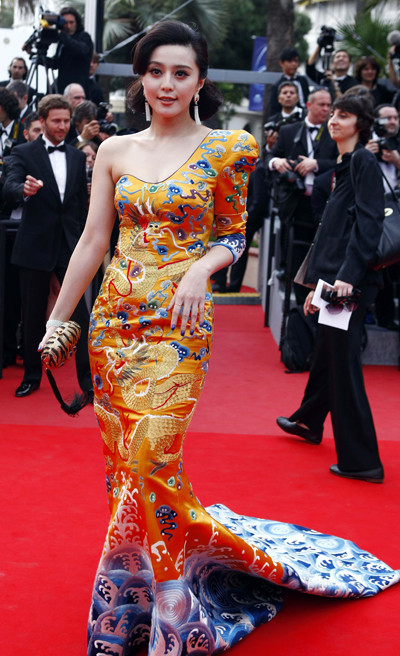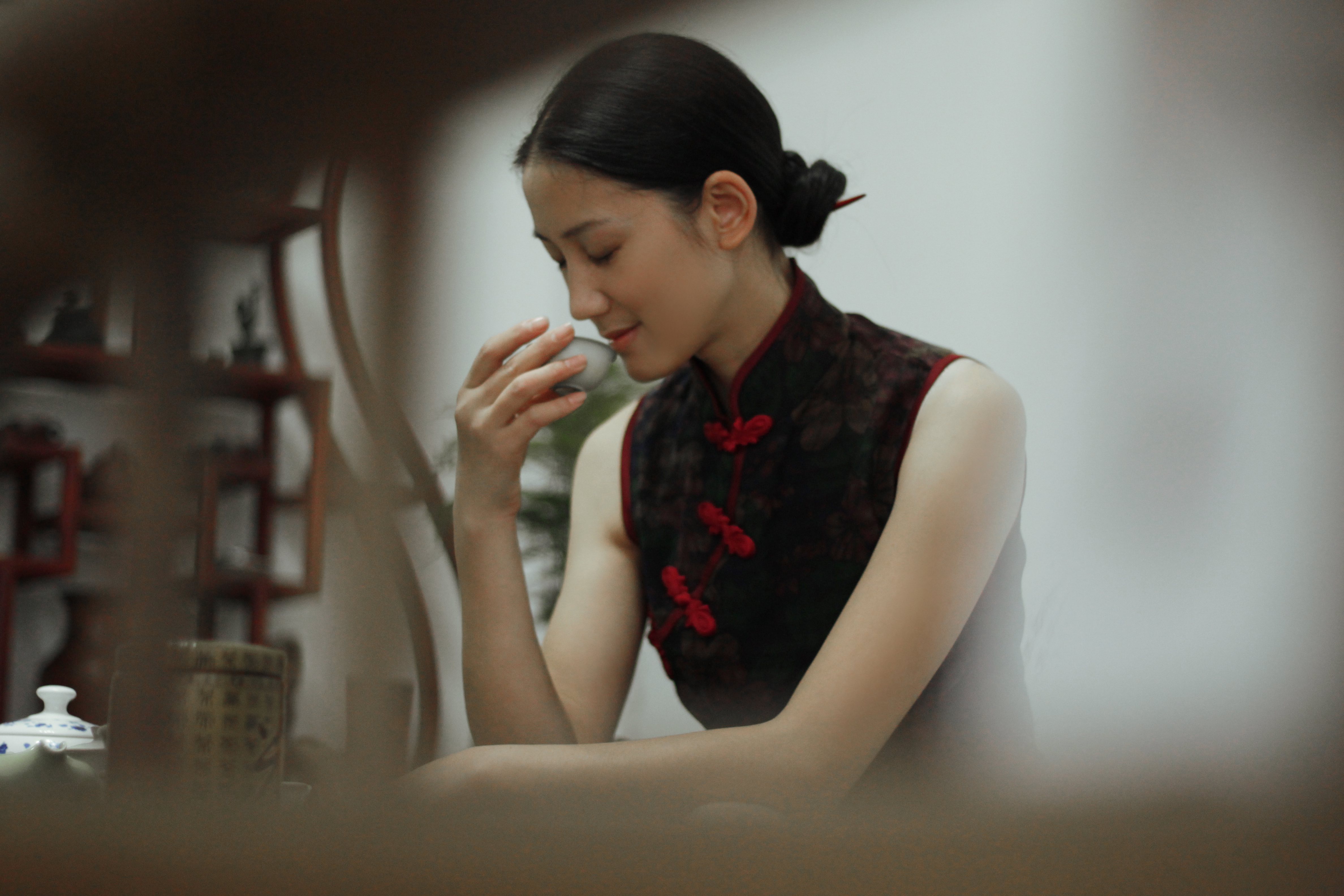The Cheongsam – the Mirror of Beauty
In May 2010, the famous Chinese actress Fan Bingbing (范冰冰) appeared at the 53rd Cannes International Film Festival in her fascinating cheongsam, which is a body- hugging one-piece Chinese dress for women, also known as Qi Pao (旗袍). There was a dragon and auspicious clouds on her dress. The main colour, golden yellow, was the colour of Chinese royalty in Imperial China. After this news was reported, a growing number of female Chinese stars have shown greater interest in the cheongsam.

-Actress Fan Bingbing wearing a cheongsam (Copyright: Xinhua)
The journey of the Chinese cheongsam began in 1644. The emperor of Qing Dynasty (清朝 1644-1911), Shun Zhi (顺治 1638-1661), led his army to the south of The Great Wall and set Beijing (北京) as its capital. As the Qing Dynasty consolidated its power from Ming (明朝 1368-1644), they imposed a reform on the dress. Manchu (满族) women wore a flat and straight cheongsam, its skirt long enough to cover the ankles and the collar was high as to hide the cheek and touch the ear. The long gown had wide piped sleeve and front cloth. During that period when two different costumes came into conflict with one another, two different cultures started to have an impact on each other. The result was a combination of costumes between Manchus and Han (汉): the cheongsam became loose and had larger sleeves and its jacket became longer.
Although the cheongsam came from the gown worn by women in the Qing Dynasty, it developed a characteristic of its own and became distinct from the original gown. In 1911, the Chinese Revolution overturned the last feudal Qing dynasty. This revolution made it possible for the West to influence Chinese dress. The cheongsam enjoyed a free change towards a popular and international style. At that time, Shanghai was a centre of fashion; the most open-minded female students in Shanghai (上海) were the first ones to wear up-to-date cheongsam. Students were considered cultivated, civilised and the leaders in fashion. As a result, celebrities also took pride in wearing cheongsam.
In the period between the 1920s and the 1940s, cheongsams had become the expression of Chinese women’s dress. In the 1920s when the cheongsam was catching on, the design began to purposefully showcase the beauty of women’s figure. In the 1930s, the cheongsam had changed totally from its original form into a distinctly modern style. The style was well rounded, perfectly accentuating the shape of a woman’s body. It made little allowance of change for new cheongsam designs afterwards. Changes could only be made in length, size or accessorial ornament. In the 1940s, almost all the popular calendars, posters as well as advertisements were printed with pictures of beautiful women wearing cheongsams.
The cheongsam has mainly two types, the Shanghai style and the Beijing style. Upper-class women in Shanghai enjoyed a luxurious life and were after fashion. The international trend of the clutched waist style contributed to the appearance of tight-fitting and high slit in the Shanghai style cheongsam. Different from the modern Shanghai style cheongsam, the Beijing styles were relatively more classical. Their designs followed the traditional cheongsam style: straight, loose and large fronts. The cloth was mainly silk and satin. A famous Beijing brand of cheongsam is Rui Fu Xiang (瑞蚨祥).

-A Chinese girl in a cheongsam (Copyright: Chen Que)
There is a long history of one hundred years behind the Chinese cheongsam. It has evolved with the times while keeping its original beauty. Nowadays, people would put on their favourite cheongsam to attend pageants or other important events. During a wedding, Chinese women always first wear the Western white wedding dress. After the ceremony, the bride will put on the beautiful captivating red cheongsam and propose a toast with the bridegroom to their families and friends. In Figure 3, my friend is wearing the red cheongsam on her wedding day. As a little girl, I would always long for my mother’s cheongsam. Many times I have furtively dressed up in her cheongsam with matching high heels. I was one of the girls who always dreamed of wearing the pretty cheongsam at my own wedding.
Since Fan Binging’s famous appearance in Cannes that summer of 2010, I remember the cheongsam reaching another high point. Chinese women, young girls as well as middle-aged women, started to wear this traditional dress in daily life. Instead of the exquisite cliché, designers have developed different kinds of reformative modern cheongsam for those trendy women. They made it conveniently shorter and lighter to wear. As a result, women enjoyed the new cheongsam which could make them look more charming, even sexier.
Cheongsams are frequently presented in contemporary movies, such as Lust, Caution (2007《色,戒》), The Message (2009《风声》), In the Mood for Love (2010《花样年华》), The Flowers of War (2011《金陵十三钗》) and The Grandmaster (2013《一代宗 师》). The heroines in these movies have the chance to wear delicate cheongsams. Besides the movies, we can also see some airline stewardesses wearing cheongsams, such as Sichuan Airlines (四川航空), Hebei Airlines (河北航空), Kunming Airlines (昆 明航空) and West Air (西部航空).
The cheongsam is like a mirror: it reflects the mysterious beauty of the Chinese woman and witnesses the vicissitudes of recent Chinese history. A woman’s pride, confidence , sorrow, or regret––all of these are part of the emotion closely connected with their cheogsams. Secrets are concealed under the dress; it drives you to seek inward into a woman’s heart. The cheongsam not only shows their beauty; but more importantly, it also enables exquisite women to express every emotion. Besides reflecting the beauty of woman, the cheongsam witnesses the recent history and reflects its own development. From a dress for the Manchu, an ethnic minority, to a popular dress throughout contemporary China, the cheongsam experienced many changes over the years. From a conservative gown to a formal dress or even modern dress for daily wear, it enables innumerable women to enjoy the beauty of the cheongsam.
 Share on Facebook
Share on Facebook Share on Twitter
Share on Twitter Share on LinkedIn
Share on LinkedIn